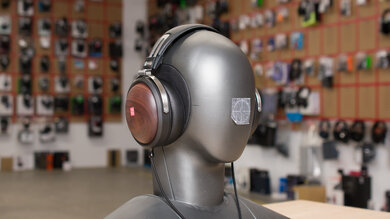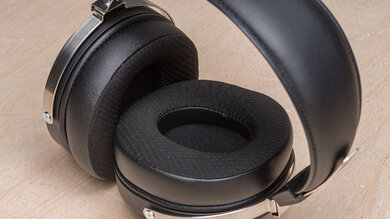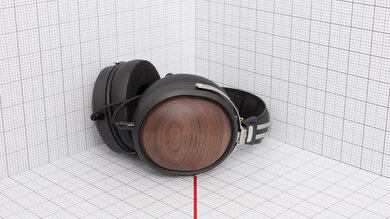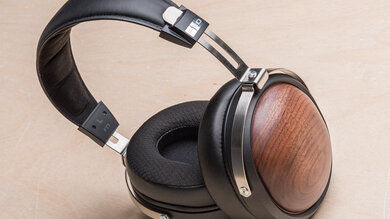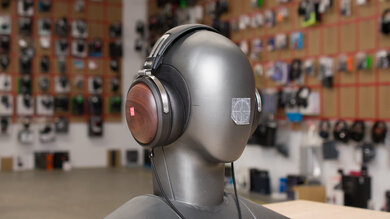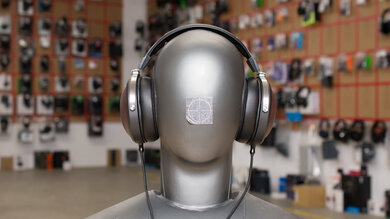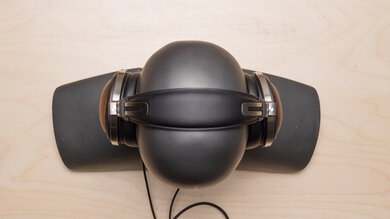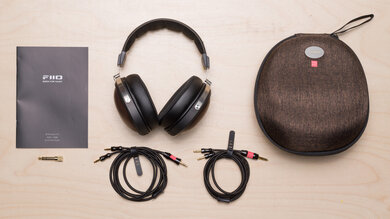FIIO has made a name for itself as a competitively priced audio enthusiast company with products that fill niches like standalone portable audio players, headphone amps, and even portable cassette decks, and the FIIO FT1 represent an entrance into the closed-back headphones field. While most people are satisfied with using a smartphone and a streaming service, FIIO caters to the audio obsessive. The brand often features attractive designs, and these closed-backs are no exception, with wooden exteriors, thick ear pads, and a headband that looks the business. Housing large 60 mm drivers, there are also promises of hefty bass at stake.
Our Verdict
The FIIO FT1 are inadequate for sports and fitness use. They're big, bulky, and not very stable. Their cabled design is liable to snag on gym equipment, and they'll slide around or even fall off if you do anything beyond standing bicep curls. These are made for relaxed or seated listening sessions.
-
Smooth peaks and dips performance.
-
Build quality is variable depending on the version you own.
-
Fit isn't very stable.
-
Not very portable and bulky.
The FIIO FT1 are unremarkable for travel. They're bulky and don't fold down smaller. While their case makes it easier to carry them, they're not very convenient. They also don't block out much background noise, except taming high-pitched sounds like squealing bus brakes, but you'll hear passengers and ambient din. Nevertheless, they're comfortable headphones with ample cushioning, and they don't need an amp to drive them, making them friendly with most airplane entertainment consoles.
-
Comfortable fit.
-
Includes carrying case.
-
Smooth peaks and dips performance.
-
Build quality is variable depending on the version you own.
-
Poor noise isolation.
-
Not very portable and bulky.
The FIIO FT1 are poor for office work. They struggle to isolate you from distractions at work, due to their passive-only isolation. They also lack a mic, detracting from the versatility most expect of headphones for work duties like online meetings. Still, they're very comfortable headphones, so if your office is private and you don't take many calls, they could do the trick.
-
Comfortable fit.
-
Smooth peaks and dips performance.
-
Build quality is variable depending on the version you own.
-
Poor noise isolation.
-
Not very portable and bulky.
The FIIO FT1 are wired-only headphones.
The FIIO FT1 are alright for wired gaming. Their analog connection that doesn't need an amp ensures latency-free audio. They're comfortable to wear and give action-packed scenes extra low-end for greater immersion. Voices sound natural for the most part, too. However, they're prone to frequency response inconsistencies, so if you wear glasses, it weakens the bass a lot. They're also not very stable, so if you move around a lot, they'll slide around, which is distracting. Since they're straightforward passive headphones, you can't change their tuning, and you'll need an outboard microphone if you want to chat with others.
-
Comfortable fit.
-
Smooth peaks and dips performance.
-
Overall good audio reproduction accuracy.
-
Prone to frequency response inconsistencies.
-
Build quality is variable depending on the version you own.
-
Fit isn't very stable.
The FIIO FT1 have great audio reproduction accuracy. Their warm tuning with low-end emphasis is smooth without many peaks and dips. Their mids and treble are rather even, too, and comply very well with our target curve. Overall, the L/R drivers are well-matched. Although there are some phase differences between the drivers, the measurements skirt the audibility thresholds on our pair, and so the phase is unlikely to noticeably affect your listening experience with real-world material. They also exhibit low harmonic distortion for a clean signal, and while they don't immerse you the way that an angled reference speaker does, they still interact with your outer ears to give a sense of space.
The FIIO FT1 have bad noise isolation, as is typical for headphones that only passively isolate. These closed-backed headphones muffle sharp and bright noises somewhat, but scarcely affect mid-range sounds like chatter. Low-pitched noises, such as HVACs and rumbling bus engines, will still reach your ears.
The FIIO FT1 don't have a microphone.
The FIIO FT1 have disappointing frequency response consistency. They're prone to notable deviations in the bass range across people with different characteristics. While people with glasses experience a big drop in bass, people with larger-than-average heads or long hair hear even more low-end than their measured raw frequency response.
- 5.7 Sports And Fitness
- 6.4 Travel
- 4.7 Office Work
- 4.6 Wireless Gaming (In Development)
- 6.7 Wired Gaming (In Development)
Performance Usages
- 8.3 Audio Reproduction Accuracy
- 5.2 Noise Isolation
- 0 Microphone (In Development)
- 5.1 Frequency Response Consistency
Changelog
-
Updated May 27, 2025:
The Wired Connection section's text was adjusted for clarity.
- Updated May 21, 2025: Review published.
- Updated May 14, 2025: Early access published.
- Updated May 08, 2025: Our testers have started testing this product.
- Updated Apr 16, 2025: The product has arrived in our lab, and our testers will start evaluating it soon.
Differences Between Sizes And Variants
The FIIO FT1 come in two color variants, 'Black Walnut' and 'Beech.' Besides the small details of what it's like to handle the walnut compared to beech housings, we expect that our 'Black Walnut' unit (which doesn't have a label on it) will perform the same as the 'Beech.' It's also worth noting that, according to the manufacturer, headphones distributed after November 2024 have an updated hinge design that's meant to be more durable. Since our pair has the revised hinge design, we can't comment directly on the previous design's performance, but it appears that other components aren't changed, so we expect a similar performance for most metrics, like sound and isolation.
If you find other variants, please let us know in the comments.
Compared To Other Headphones
Many of the closed-back audiophile headphones we've reviewed are either purpose-built studio headphones with less bass emphasis or considerably more expensive than the FIIO FT1, like the Beyerdynamic DT 1770 PRO or the Focal Elegia. We've only reviewed open-backed HiFiMan headphones, so while the closed-back Sundara model might be a competitively-priced alternative, we haven't tested them. However, the FIIO FT 1 are a good closed-back, bassy alternative to offerings like the value-driven HiFiMan Sundara 2020 open-backs. That said, the HiFiMan cans use planar magnetic tech compared to the FIIO, which utilize large 60 mm dynamic drivers.
While the FIIO look more upscale than the similarly priced closed-backed AKG K361, both offer a bit more bass but with completely different pros and cons. The AKG are much lighter with a gentler clamping force and a folding frame, but their frequency response consistency is even more susceptible to variations than the FIIO. The Audio-Technica ATH-M50x are another evergreen pair of closed-backs with a more utilitarian vibe and feel, and their sound signature is more balanced with a bit of extra boom, but their deep bass is otherwise more relaxed compared to the FIIO. The Audio-Technica cans aren't as punishing to people with glasses when it comes to consistency, though our pair's left and right drivers aren't as well-matched as the FIIO's, and also have worse group delay performance, resulting in a looser bass response.
Check out the best closed-back headphones and the best over-ear headphones. If you're a fan of bassier tunings, consider the best DJ headphones.
Between the AKG K371 and FIIO FT1, the choice mostly depends on whether you prefer a more balanced Harman-style curve or a warmer and bassier sound profile. Apart from that, the AKG are a little more portable due to the lighter weight and foldable design. They're also fairly low-profile for closed-back over-ears. You get a generous three cables with the AKG, but only the FIIO include a balanced cable. Meanwhile, the FIIO are chunkier, heavier, and not portable, though the zip case is nice. Because both have similar cons like disappointing frequency response consistency and noise isolation, your choice will still probably come down to the kind of tuning and visual styling you prefer.
The HiFiMan Sundara 2020 are open-back audiophile headphones, while the FIIO FT1 are closed-backs, so they have different strengths. If you want headphones that interact with your environment for a more immersive sound, the HiFiMan are the better pick. However, you can't wear them in as many different sorts of places because they don't isolate and leak a lot of audio. They're also flatter and less bassy-sounding than the FIIO, which are warm-sounding with a deeper bass. While tuning comes down to taste, the notably more consistent frequency response on the HiFiMan ensures predictable sound between wears and people. Still, for a warmer, bassier sound and a comfortable fit that you can wear in more situations, the FIIO might be better, depending on your needs.
The Beyerdynamic DT 770 PRO are better built closed-back over-ears with tighter L/R matching than the FIIO FT1. However, whether you'll like the Beyerdynamic cans more than the FIIO also depends on your preferred tuning, as the Beyerdynamic have a conservative bass and a bright treble, while the FIIO are considerably bassier with a warmer top-end. On the other hand, the FIIO leak less of your audio and block out noise a bit better. The FIIO are much easier to drive with different audio sources than the 250Ω version of the Beyerdynamic we reviewed, and you can easily swap out the FIIO's cable, whereas the Beyerdynamic's cable is hardwired.
The Sennheiser HD 620S and FIIO FT1 are both very comfortable closed-back headphones. Which you'll like best relies on whether you want a more laid-back, balanced tuning, as with the Sennheiser, or a warmer, bassier sound profile, as with the FIIO. The Sennheiser are better built with tighter L/R driver matching. However, you get fewer accessories, like a single average 3.5mm cable and basic pouch, which cheapens the package somewhat. The FIIO, on the other hand, are more visually arresting, with wood on the ear cup housings, and they also come with a proper zip case and a second balanced audio cable. While neither pair has great frequency response consistency, the FIIO are slightly better in this regard, but it's worth checking the graphs to see how people with your anatomy or accessories (head size, hair length, glasses, etc) fare when wearing them.
Video
Test Results
The FIIO FT1 have an overall warm sound signature. The frequency response loosely follows our target, but with more low-end and mids. The 60 mm drivers are capable of adding extra low frequencies to the mix, while the mids are a little uneven and slightly elevated relative to our target curve, due largely to slight stereo mismatch. Most of the top-end is balanced, albeit with peaks and dips and more L/R mismatch. That said, your experience of these headphones will be strongly influenced by how well they fit you.
The FIIO FT1 have bad frequency response consistency. In particular, those with glasses experience a noticeably weaker bass than people with small heads or long hair due to a fussy over-ear seal. If your head is average in size, the sound is much closer to the measured response in the Sound Profile, though.
The headphones do an excellent job of complying with our bass profile target. Across the range, they emphasize low frequencies with a touch more boom and punch on the thuds of kick drums and weighty basslines on tracks like Bookends by U.S. Girls.
The mid-range target compliance is remarkable. Keys, guitars, and speech all come across as present and mostly natural-sounding. Sensitive listeners might detect a slightly honky quality to vocals, but it's quite minor. Most of the range is a little over-emphasized, and there are points of stereo mismatch between the L/R drivers with small peaks and dips, but these are also minor.
The FIIO FT1 have superb treble profile target compliance. Besides a couple of peaks in the mid-treble, the region is mostly a little under-emphasized. Keeping in mind the effect of the extra dose of bass on the overall sound, this otherwise fairly balanced treble response sounds somewhat warm in the context of real-world content. All that said, voices can sound just a little unclear, while depending on the pitch, harmonics from cymbals splash with detail and sparkle.
The FIIO FT1 have very good peaks and dips performance. The bass and mid-ranges are smooth, for the most part, without narrow bands of frequencies being exaggerated or dipping strongly. Although the mid-range response isn't as smooth as a pair of headphones like the Sennheiser HD 490 PRO, for example. The treble range is a bit less controlled, with a series of peaks and valleys that can cause sounds like cymbals to be alternatively somewhat veiled or harsh and piercing, depending on their pitch.
The FIIO FT1 have very good stereo mismatch performance. The L/R drivers are tightly matched in weighted amplitude. There's a bit of weighted frequency response mismatch in the L/R drivers, with a bump in the mids on the right relative to the left, which also correlates with some of the phase mismatch present across the range.
The phase response graph shown is an average with an audibility filter applied, but as these individual passes (one, two, and three) demonstrate, there are still some notable phase deviations between each side. While the peaks are larger in the treble range, these weren't obvious during listening tests. However, the averaged phase results skirt the audibility threshold, in the mid-range particularly, and while this wasn't noticeable during audio playback, it can potentially affect fidelity somewhat. That said, these results are only representative of our particular pair of headphones and not valid for other units.
Their group delay performance is great. It mostly falls below the audibility threshold across the tested frequency range. Bass sounds tight, and transients in the mid-range and treble sound transparent. There are small peaks of elevated delay approaching the audibility threshold in the low frequencies, but they're quite narrow, so bass doesn't sound loose.
The FIIO FT1 have adequate PRTF measurements, indicating some interaction with your ear's pinna. This mainly occurs in the high-treble, so it doesn't quite mimic the experience of listening to audio from an angled reference speaker, but it can lend a feeling of distance to your audio.
These headphones exhibit excellent harmonic distortion performance. When pushed at 94 dB/SPL and 104 dB/SPL, each frequency plays back cleanly without deteriorating the signal.
These headphones don't need an external amp to drive them. So you can connect them to your laptop's headphone jack and expect good output volume.
These are the settings used to test these headphones. Our results are only valid when used in this configuration.
The FIIO FT1 are closed-back, over-ear headphones with wood shells for the outer housings. Our pair is 'Black Walnut' with black padding and silver yokes, but they also come in 'Beech,' which are silver and beige with a lighter-colored wood exterior. They have a Y-cable design with detachable cables included and thick ear pads.
The closed-back headphones are very comfortable. Their ear pads are amply cushioned and covered in leatherette and soft fabric that makes contact with your skin. The headband isn't the most padded, but it feels good. If you wear glasses, it can be harder to get a comfortable fit without breaking the over-ear seal, and they do clamp fairly hard, with most of the force concentrated on the top of the ear cups rather than evenly distributed around your ears. Since the ear pads have oval-shaped openings, some people might need to make adjustments to fit their ears.
These headphones aren't very portable. They're large over-ears that don't fold down smaller and are intended for at-home use. You can disconnect the cable, though, which keeps it from snagging.
The included zip case is good. It fully closes and it's a semi-hardshell with a fabric exterior and a fabric loop for toting it with you or hanging from a hook. There's a bit of give, but it ought to protect the cans from most scrapes, even if it's not crushproof. It also serves to ward off a few raindrops, but there's no IP rating, of course. Unfortunately, there isn't additional padding on the case's interior.
The FIIO FT1 headphones have a satisfactory build quality. Initial units were shipped with screws that would loosen and were prone to breaking, resulting in the ear cup fully separating from the headband. This was reported widely, and people had mixed experiences with customer service when addressing the issue (1, 2, 3), though it's fixable. Since November 2024 the manufacturer updated the design, so new units, including ours, have been shipped with a revised screw design that appears to hold up better. Still, the swivelling yokes are a little stiff but also seem like they'll loosen up too much over long-term use.
On the upside, the ear pads are well-made, don't warp with use, and are removable. The cables are also removable, and click into the ear cups without wiggle room and seem to have a chunkier, braided build. The headband is decently wide with enough padding to ward off fatigue after an hour of wear. The housings seem decently solid with tight seams.
The FIIO FT1 have disappointing full-range noise isolation, but that's not unusual for passive isolating headphones. They mainly muffle high-pitched frequencies like squeaky door hinges, and slightly tame voices. But they don't block out voices or deep rumbling sounds like passing construction trucks.
These headphones have bad isolation in common scenarios, which is expected, considering they don't benefit from active features like active noise cancelling. That said, they block higher-pitched sounds somewhat like dishes clattering during clean-up.
Their leakage performance is good. Depending on how loud your volume is set and your proximity to other people, they aren't too bothersome in the average office space. If your office is quite quiet, a somewhat full version of your audio is audible. At home, you won't annoy the family with escaping music.
The FIIO FT1 come with two 1.5 m (4.9ft) audio cables. You can choose between a standard mini headphone jack (3.5 mm / 1/8") or a 4.4 mm balanced connection for virtually latency-free audio with analog sources. Plus, there's a 1/8" to 1/4" adapter, so you can plug into your laptop with the cable's smaller 1/8" jack or use the adaptor to connect to an old-school synthesizer without having to swap the cable out.
You can connect these headphones via their 3.5 mm (1/8") cable to your PC to receive audio. They don't have a microphone, so you'll need an outboard one if you're taking meetings or gaming.
You can plug the 3.5 mm (1/8") audio cable into your PlayStation's controller for audio playback. They don't have a mic, though.
These headphones can connect to your Xbox controller for audio only. They don't come equipped with a microphone, so you'll have to get an outboard one to talk with your teammates.



